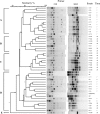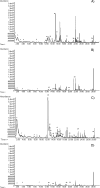Spoilage-related activity of Carnobacterium maltaromaticum strains in air-stored and vacuum-packed meat
- PMID: 21784913
- PMCID: PMC3194841
- DOI: 10.1128/AEM.05304-11
Spoilage-related activity of Carnobacterium maltaromaticum strains in air-stored and vacuum-packed meat
Abstract
One hundred three isolates of Carnobacterium spp. from raw meat were analyzed by random amplification of polymorphic DNA (RAPD) and PCR and were identified by 16S rRNA gene sequencing. Forty-five strains of Carnobacterium maltaromaticum were characterized for their growth capabilities at different temperatures, NaCl concentrations, and pH values and for in vitro lipolytic and proteolytic activities. Moreover, their spoilage potential in meat was investigated by analyzing the release of volatile organic compounds (VOCs) in meat stored in air or vacuum packs. Almost all the strains were able to grow at 4, 10, and 20°C, at pH values of 6 to 9, and in the presence of 2.5% NaCl. The release of VOCs by each strain in beef stored at 4°C in air and vacuum packs was evaluated by headspace solid-phase microextraction (HS-SPME)-gas chromatography-mass spectrometry (GC-MS) analysis. All the meat samples inoculated and stored in air showed higher numbers of VOCs than the vacuum-packed meat samples. Acetoin, 1-octen-3-ol, and butanoic acid were the compounds most frequently found under both storage conditions. The contaminated meat samples were evaluated by a sensory panel; the results indicated that for all sensory odors, no effect of strain was significant (P > 0.05). The storage conditions significantly affected (P < 0.05) the perception of dairy, spoiled-meat, and mozzarella cheese odors, which were more intense in meat stored in air than in vacuum packs but were never very intense. In conclusion, different strains of C. maltaromaticum can grow efficiently in meat stored at low temperatures both in air and in vacuum packs, producing volatile molecules with low sensory impacts, with a negligible contribution to meat spoilage overall.
Figures




References
-
- Afzal M. I., et al. 2010. Carnobacterium maltaromaticum: identification, isolation tools, ecology and technological aspects in dairy products. Food Microbiol. 27:573–579 - PubMed
-
- Axelsson L. 2008. Lactic acid bacteria: classification and physiology, p. 19–66 In Salminen S., von Wright A., Ouwehand A. (ed.), Lactic acid bacteria: microbiological and functional aspects. Marcel Dekker, New York, NY
-
- Borch E., Molin G. 1989. The aerobic growth and product formation of Lactobacillus, Leuconostoc, Brochothrix, and Carnobacterium in batch cultures. Appl. Microbiol. Biotechnol. 30:81–88
-
- Borch E., Kant-Muermans M. L., Blixt Y. 1996. Bacterial spoilage of meat and cured meat products. Int. J. Food Microbiol. 33:103–120 - PubMed
Publication types
MeSH terms
Substances
LinkOut - more resources
Full Text Sources
Molecular Biology Databases
Miscellaneous

